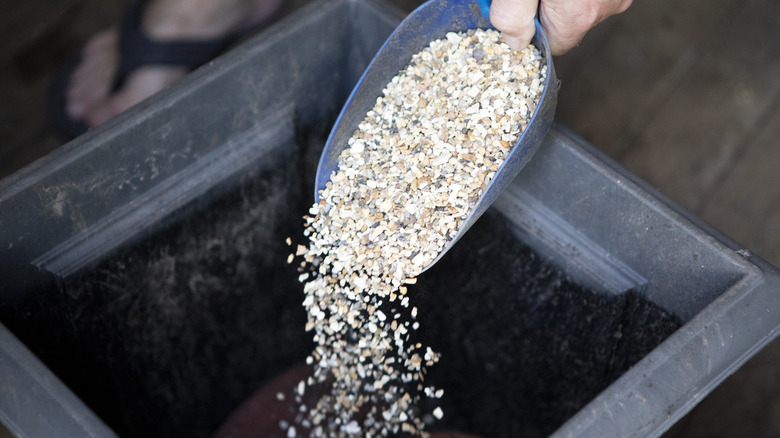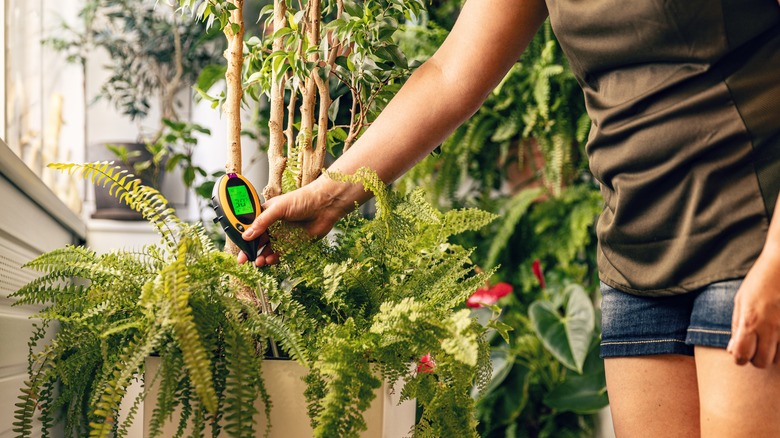Don't Believe These Sand And Gravel Myths For Pots Without Drainage
Houseplant experts are constantly emphasizing the importance of proper drainage and why it is vital to the health of plants. Allowing the soil to dry out reduces the chance for root rot or oversaturation, which can lead to fungus gnats. However, it's not uncommon to buy a houseplant that is in a pot without drainage holes or to talk to other plant parents who swear by the common plant pot drainage "hack" of adding sand or gravel to the bottom of pots.
In theory, adding sand or gravel to your potted houseplant makes sense — the idea is to increase drainage and aeration, both of which are beneficial to plants. However, in an exclusive interview with House Digest, Sam Arthurs, head gardener for Local Matters and House Digest's flower specialist, disagrees with this practice. When asked about adding sand, she said, "Sandy soils exist naturally, and sand is added to certain potting mixes to help with drainage for desert plants like cacti. However, this 'better drainage' is in combination with drainage holes. The excess water still has to go somewhere, and for the sake of the plant, you want it to go out of the pot. So sand at the bottom isn't better than gravel when used at the bottom of a pot with drainage." She added, "To that point, adding gravel isn't even a good technique to have."
How sand and gravel impact houseplants
In an exclusive interview with House Digest, Sam Arthurs elaborates on the downsides of using sand and gravel in pots without drainage. "The cons to using sand is that you're basically putting a reservoir at the bottom of the pot for water to sit," Arthurs said. "This could lead to overwatering because the top feels dry while there's already too much water sitting at the bottom. While gravel has the same problem, you would at least need less of it. The sand could also add unnecessary weight, especially when wet."
In other words, adding supplemental materials — sand, gravel, shards of old pots — to planters defeats their intended purpose and actually does more harm than good. Even though it makes sense to picture water easily trickling through the cracks in a layer of gravel, that is actually not the case. When multiple materials are layered within a pot, water doesn't move down to the level of coarse material (like gravel) until the upper layer of finer substance (like dirt) is fully saturated. And when it comes to plants, we don't want anything oversaturated.
Tips for proper drainage and watering
Proper drainage is key to growing a healthy plant, and adding sand or gravel is not an effective way to do this. So what are better options? "It is better to drill drainage holes into the pot rather than filling it with gravel, sand, pot shards, etc.," suggested Sam Arthurs in her exclusive interview with House Digest. "If you can't or refuse to drill holes, then at least get very good at watering. Too little will keep the roots growing near the top of the soil, and too much will lead to root rot. You'll have to get the perfect amount into the pot, and then you will need to make sure that the water is mostly absorbed before watering again."
Since it's hard to discern what exactly is taking place in your planter, Arthurs recommended using a moisture meter for houseplants. This tool will give you an accurate measurement of how wet the soil is deep within the pot and whether or not you need to water your plant again. Stuck with a pot without holes? The easiest way to add drainage holes to your ceramic or clay planter is to simply drill holes in it. If the pot is made of plastic, just poke holes into the bottom with scissors or a screwdriver.


